
Hang Snatch Exercise Guide

The hang snatch is a snatch variation that is popular among Olympic weightlifters, competitive fitness athletes, and sports athletes alike. It can work to increase the rate of force development at the hip, enhance snatch technique, and even be used to increase explosiveness in all level athletes. Therefore, in this article we will discuss in high detail everything you need to know about the hang snatch, specifically:
In this hang snatch exercise guide, we'll cover multiple topics including:
- Hang Snatch Form and Technique
- Benefits of the Hang Snatch
- Muscles Worked by the Hang Snatch
- Who Should Do the Hang Snatch?
- Hang Snatch Sets, Reps, and Programming Recommendations
- Hang Snatch Variations
- and more…
How to Perform the Hang Snatch: Step-By-Step Guide
Below is a step-by-step guide on how to perform the hang snatch. This guide describes the “top-down” method, meaning you start at the hip and work technique in the pull the lower you go, rather than learning or teaching the lift from the floor.
Step 1. Snatch Width and Posture
Start by assuming the proper snatch width, so that the barbell is at your hip crease and your arms are straight (no elbow bend). Your chest should be tall and your posture erect, with the shoulders pulled together and down towards the hips.
The legs should be straight, with the balance of the lifter throughout the full foot.
Coach's Tip: Often, lifters will be leaning back or forward or the barbell, however for learning purposes coaches can reinforce proper upright positional strength by having a lifter standing as erect as can be, without collapsing the shoulders forwards.
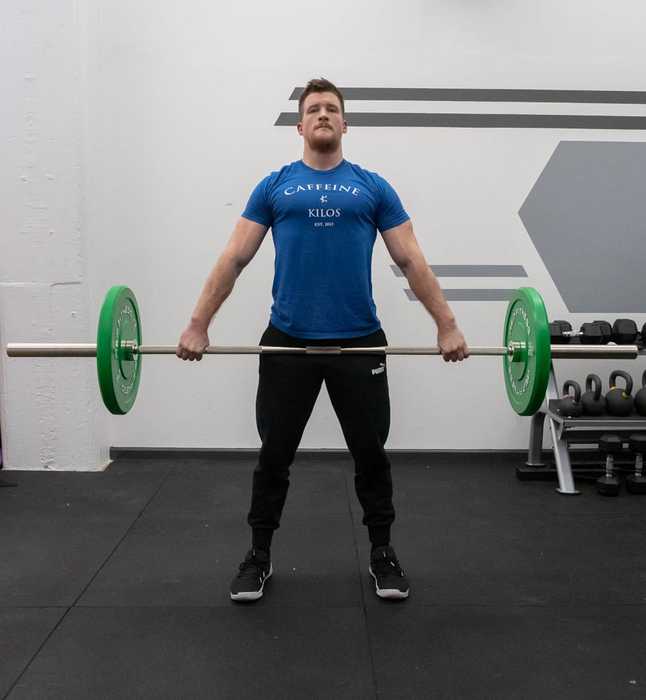
Step 2. Take a Hook Grip
For best results, use a hook grip, which is shown below. There are, however, some hang snatch variations where the lifter does not use a hook grip, which is often the case when trying to develop a stronger grip/more vertical extension.
This is a specialized grip that takes time and patience to master. Be sure to practice this on a regular basis. To perform, simply wrap your thumb around the barbell, and overlap your fingers to create a tighter seal (as shown below).
Coach's Tip: This will often feel harder to grip the barbell in the beginning, but I promise you it will be the strongest grip you can take once developed.
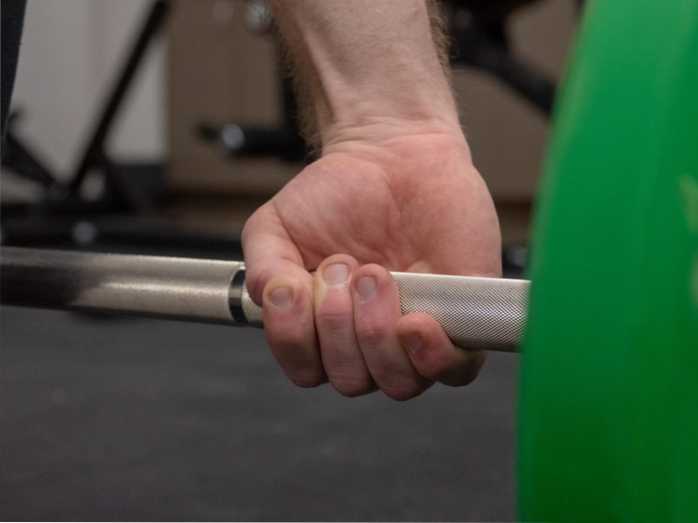
Step 3. Stay Over the Barbell
To descend into the hang, push your hips back and to allow the barbell to move down the thighs. The knees should be slightly bent so that the shins are perpendicular to the floor. It is vital to keep your chest over the barbell, so that the arms are getting pulled straight down (shoulders on top of the barbell).
At this point, a lot of lifters will place either too much weight the heels or not enough. The easiest way to approach this is to think about keeping full pressure in the entire foot, with the chest over the bar and shins perpendicular to the floor.
Coach's Tip: If you find yourself getting pulled on the toes, you need to really work to keep the heels down as you stay over the bar, and pull the bar into you. If you have issues of bending early with the arms (before the hip crease), this could be an indicator of you being out of balance (often leaning too far back and not staying centered in the foot with the chest and shoulders over the barbell).
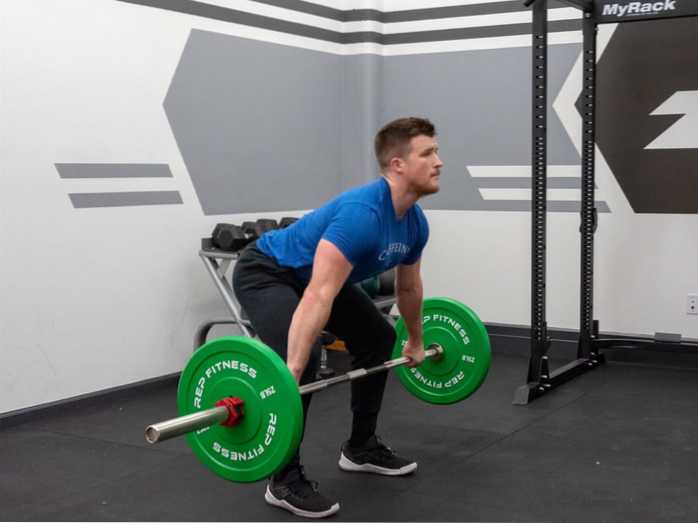
Step 4. Finish the Pull
Once you have reached the hang position (which can be above the knee, below the knee, or a few inches off the floor), you need to fully extend the torso and legs to produce a vertical force unto the barbell. It is at this phase that many issues can arise.
As you stand up with the legs, you need to be sure to keep the weight back into the heels while still having the toes in contact with the floor. The instant you either sit too far back or too far forward, you add a detrimental horizontal force to the barbell (pushing it out). The key is to continue to deadlift the barbell to the hip crease, keeping the chest over the bar and the barbell close to the body. Additionally, many lifters will stop pulling after hip contact, however you need to continue to pull the elbows and wrists high after the hip, similar to muscle snatches, snatch high pulls, and tall snatches. This will help to keep the barbell trajectory vertical and increase your ability to secure a better receiving position.
Coach's Tip: In it's simplest form, this step should involve the lifter pull the barbell up to the hip, making contact, and then pulling themselves down into the squat (with that traps, back, and arms).
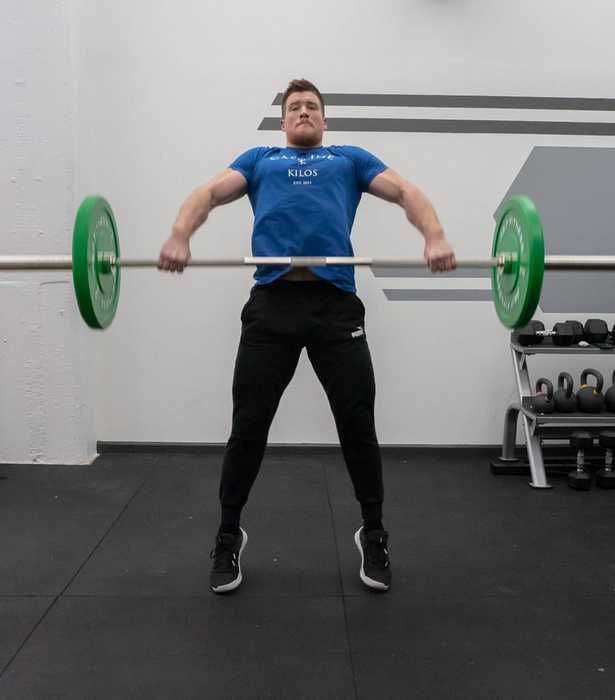
Step 5. Receive the Barbell
If you have done everything correct, this phase should be pretty smooth. If you have done all aspects (steps 1-4) correctly, and have issues assuming a low and stable position, you may also need to determine if your overhead squat mobility/positional strength is an issue.
In the snatch, the lifter should either lift or slide the feet outwards about one foot-width after finishing the pull (step 4) to allow for faster movement under the bar (pick or slide the feet up off the floor). This occurs in unison with a strong upwards pull on the barbell after contact (resulting in high elbows in the finish of step 4.
Coach's Tip: Many lifters fail to stay aggressive after making hip contact, which impacts this step immensely. If you feel unstable, weak, or that the barbell is crashing down on you (which can also be due to it being too far forward), you need to go back to steps 3 and 4 and master the pull and final extension process.
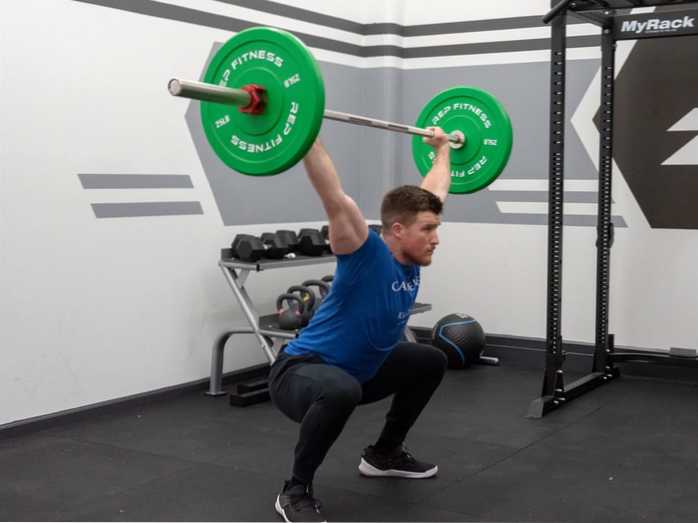
Step 6. Reach and Stand Up
With the elbows locked out and the barbell slightly behind the head (over the traps), actively push up through the palms and into the barbell, as you stand up from the squat.
Do not be afraid to sit down in the bottom of the squat if you need to stabilize the load overhead prior to standing it up. Many lifters will rush out of the receiving position, lacking stability, and missing the lift. It can be helpful to include 3-5 second pauses in the step 5 position to aid in overhead squat stbaility and strength.
Coach's Tip: Two cues commonly heard at this stage is “reach” and “push” both of which trigger actively pushing upwards through the barbell to aid in a stable and strong recovery from the squat.
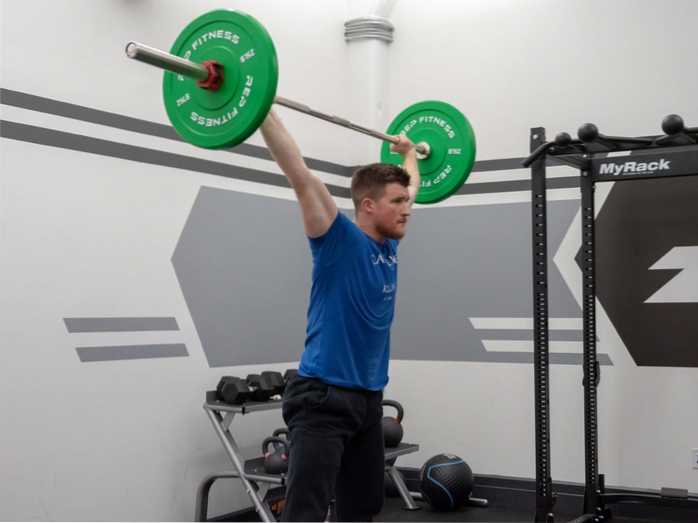
Hang Snatch Disclaimer
Before we dive in, I need to address the fact that many people may be snatching or hang snatching without taking the time to address mobility concerns and fundamental hypertrophy and muscle development in the upper back, arms, shoulders, and core.
Throughout this article I will discuss the hang snatch, however at all times I highly recommend that prior to engaging in such exercises you (1) be sure to seek out a qualified coach and weight lifting progressions who not only hold proper accreditation, but also has marked experience to back themselves up, (2) dedicate time and effort to proper joint mechanics and bar speeds before adding loading, (3) never sacrifice form for function, especially in certain WOD and/or training situations unless you are already highly skilled in such movements.
3 Benefits of Hang Snatches
Below are three (3) reasons why you should start to include hang snatches into your training program as a weightlifter, CrossFit athlete, fitness enthusiast, and sports athlete.
Increased Athleticism
Increased rate of force production, motor patterning, hip extension and posterior chain performance, integrated movement, proprioception, and kinesthetic sense are all attributes that can be taught and developed by movements like the hang snatch. While you can develop some of these using other movements, the hang snatch (and hang clean) can offer you a unique exercise solution for maximizing your time and training.
Teaching the Snatch
The hang snatch is a good snatch regression for coaches to teach all level lifters and sporting athletes, as it is a shorter range of motion and allows for greater emphasis on powerful hip extension (often the purpose of it when found in strength and conditioning programs for formal sports).
Snatch Technique Issues
The hang snatch can be first integrated into many weightlifting and functional fitness programs to develop a lifter's ability to finish their pull and perform the full snatch. Many lifters fail to comprehend or master the full movement of the snatch (starting from the floor) at the onset of training, therefore making the hang snatch a good “top-down” teaching progression. Additionally, the hang snatch can be used for more advanced lifter to increase rate of force development, increase the height of the second pull, and ultimately increase a lifter's final hip extension before becoming fixated unearth the barbell in the receiving position.
Muscles Worked - Hang Snatch
The hang snatch is a complex, total-body movement that utilizes many of the larger (and smaller) muscles groups of the body. It relies heavily on the back, legs, and shoulders, however even muscle groups like the traps and triceps are worked. Below is a general listing of the muscle trained and developed by the hang snatch.
It is important to note that eh hang snatch, like most weightlifting movements, do not involved large amounts of eccentric loading (other than the hamstrings), and therefore is not the best exercise to increase muscle hypertrophy, but rather explosiveness and athleticism.
- Hamstrings, Glutes, and Erectors
- Latisimus Dorsi (back)
- Shoulder/Scapluar stabilizers
- Biceps and Forearms
- Triceps
- Shoulders
- Trapezius
- Calves
- Quadriceps
Who Should Perform the Hang Snatch?
The hang snatch is an explosive exercise that can be used to increase athletic performance , improve explosiveness, and enhance your competition PRs.
Strength and Power Athletes
The hang snatch is often seen in Olympic weightlifting and can be used to address primary strength issues and timing in the full. Additionally, this exercise can be used by non Olympic weightlifter (strongman and powerlifting athletes) as a general explosiveness movement, such as jumps, high pulls, and clean pulls.
- Weightlifters: The hang snatch is highly beneficial for Olympic weightlifters as it is a direct variation of the competitive movement. Hang snatches can be used to increase the second pull abilities of the lifter, especially rate of force development and increasing pulling height in the snatch. Additionally, hang snatches can be a great way to increase loading of lifters who may have technical issues with below the knee pulls, and therefore you can help them get acclimated with heavier loads above the knee to allow them to feel more confident with heavier loads from the floor.
- Powerlifters and Strongman Athletes: While snatching isn't entirely specific to powerlifting or strongman, I do find that the integration of the total body in this highly explosive movement allows strength athletes to increase force production, back strength, and enhance overhead performance. The ability to integrate snatches into a routine can also help to build in metabolic movements, integrated athlete movement, and explosiveness in somewhat slower speed sports (which at heavy loads is understandable, however the faster the neurological systems can engage force production, the greater acceleration and impulse any athlete can have on producing force, slow or fast).
CrossFitters
Hang snatches are key to snatch technique and fitness WODs, therefore many fitness athletes need to have the abilities and skill to not only perform hang snatches in a technique setting, but also under high amounts of loading to be able to withstand fatigue and/or heavier snatch attempts.
Sports Athletes
There is a debate among strength coaches as to the best Olympic weightlifting movement to increase rate of force development, increase jump and sprint performance, and overall explosiveness of their athlete while minimizing injury risks to shoulders and wrists. I personally feel that the hang snatch (even the power version) allows for less strain on the wrists and limits the amount of loading that is used (power cleans and hang cleans have significantly more kilos on the bar), therefore increasing ones need to accelerate the barbell at the hip.
Acceleration (not load) is they key attribute most strength coaches are concerned with, therefore making the snatch a good movement to invest in (time, coaching, educating athletes on technique, etc.).
General Fitness
For general fitness, the snatch may not be a necessary component to increase power, integrated movement, etc. While hang cleans could do the trick, I personally feel that most humans can and should be able to perform the basic hang snatch to demonstrate a well-balanced and integrated movement program. This may not be heavy, or full squat in the receiving phase, but any variation of hang snatch can help to increase power output, stimulate muscle growth and adaptation, and help to increase posterior shoulder performance over time (if snatches are done correctly).
Aging Populations
The ability to produce force in a rapid and controlled fashion can be highly beneficial for elderly clients who have to withstand the risks of tripping, falling, and/or other common missteps every day. Once again, even the simplest or regressions on the snatch (hang snatch, muscle snatch, power snatch) with a barbell, stick, dumbbell, etc can be beneficial for all levels and ages of individuals.
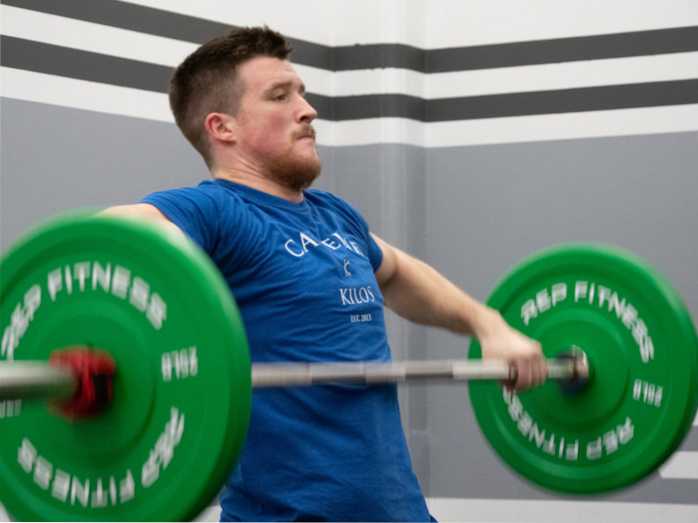
Hang Snatch Reps, and Programming Recommendations
Below are a few recommendations on how to go about programming for hang snatches. Typically, this exercise is done with the specific goals/populations in mind, rather than for general repetitions/loading/sets (such as in bench press and/or squats).
General Guidelines
If the goal is technique, power application, and sport specific training to explosive sports:
- Repetitions in the 1-3 rep range are most optimal (I find). This allows the lifter to have the greatest impulse of force production and acceleration at the terminal hip extension, and decreased the amount of residual fatigue from rep to rep (unlike sets of 10).
- The snatch is a neurological stressor, that at heavier loads can be failed due to even the slightest technical error.
If however, you are programming these for more conditioning purposes:
- I find sets of 5-10 are proper ranges (depending on loading percentage), however there is more wiggle room for such training.
- Note, that the more repetitions that occur, the greater margin for technical error, fatigue, and less transferability to heavier snatch training.
Olympic Weighlfiting
Generally speaking, for technique and developmental purposes:
- 3-5 sets of 1-3 repetitions can be used with 60-80% of one's snatch max. This will ensure technique, bar speed, and overall development of a lifter can occur.
- In more advanced training stages, heavier hang snatch can be performed at much higher loads (80-90+% snatch max) to maximize performance, enhance a lifter's confidence under massive loads, and have high transferability to near-maximal and maximal snatch lifts.
Fitness WODs
Hang snatches in a fitness WOD can be for either metabolic conditioning purposes or more of a strength/power cycle.
- Regardless of which to choose, the hang snatch should be done with integrity and a strong back.
- Failure to perform repetitions that have a lifter stay planted, finished their pull, and be active in the receiving position will have a drastically detrimental impact on heavier snatch specific training.
Hang Snatch Variations and Alternatives
Below are five (5) hang snatch variations/alternatives that can be done to improve snatch technique, timing, and performance.
1. No Foot Hang Snatch
The no foot hang snatch is done with the feet already in the wider, overhead squat position. While this slightly alters the pulling stance, this allows the lifter to not move their feet after extension (step 4-5), forcing them to properly pull the barbell vertically (rather than letting it get pushed out front). If a lifter has issues jumping forwards, collapsing in the snatch, or having weakness in the pull, this variation can be very beneficial to development.
2. Hang Muscle Snatch
This variation has the lifter perform steps 1-4, yet instead of assuming a squat to receive the barbell, they continue to extend the torso and arms upwards, pressing out the weight overhead and ending in a full erect position (like the top of a push press or strict press, just with the hands in the snatch grip). This muscle variation can be done to increase upper body strength in the pull and improve balance and pulling power in the snatch.
3. Hang Power Snatch
The hang power snatch is done identical to the hang snatch, with the only exception that the lifter does not receive the barbell in the full snatch. Rather, the lifter receives the barbell in the half squat or parallel squat position, which forces them to have a more powerful pull since the barbell must be pulled a few more inches higher than a snatch receiving int the full squat.
The BEST Snatch Articles on BarBend!
Take a look below at some of the top snatch technique and training articles out BarBend!
- 4 Exercises to Strengthen You Snatch Receiving Position (Squat)
- How to Get Faster Under the Barbell in the Snatch
- Why Most Lifters Don't Finish Their Pull in the Snatch
Featured Image: Mike Dewar



Nimeni nu a comentat acest articol încă.